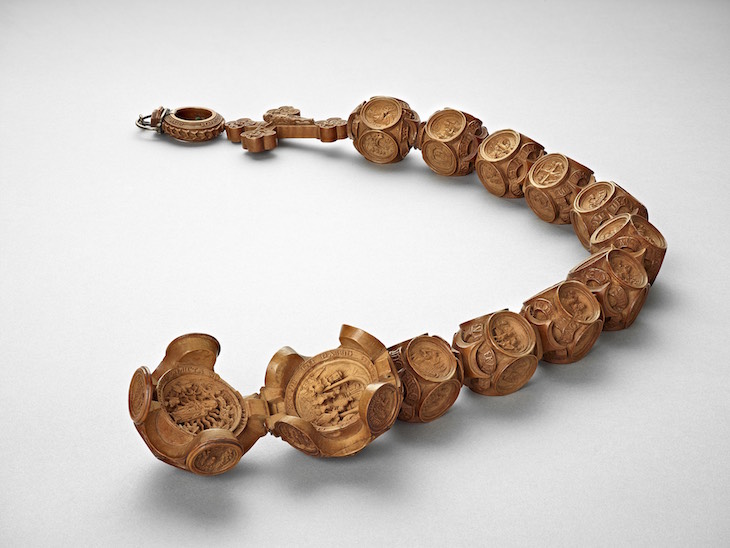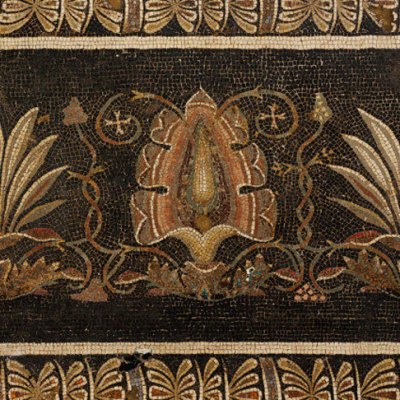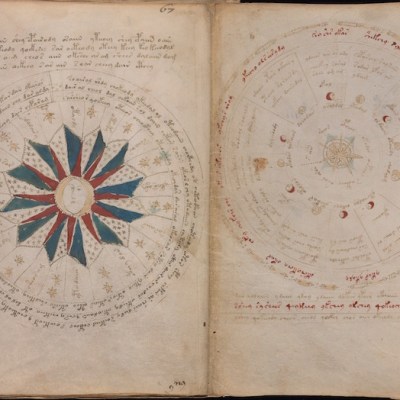It would be hard to oversell ‘Small Wonders’ at the Rijksmuseum: it is an astonishing show of astonishing objects, curated with equal measures of care and flair. The various technical tags given to the group of works on display – ‘late-gothic boxwood micro-carvings’, ‘prayer nuts’, or, even more prosaically, ‘prayer beads’ – do not do much to sell objects that are for the most part both breathtakingly beautiful and comprehension-defying in their technical virtuosity. This is a show in which carved scenes worthy of a full-sized gothic altarpiece, and comparable in detail, are found within packages designed to fit in the palm of a hand. Small wonders is an apt phrase.
Prayer nut with Crucifixion and Christ before Pilate (c. 1500–30), Adam Dircksz. and workshop. Metropolitan Museum of Art, New York

To make clear the vertiginous dichotomies of scale at play, the curators have dedicated the entire first room to a single piece, presented in front of a 100x scale photo of itself. An intricately decorated sphere no larger than 6cm in circumference, the nut hinges open to disclose six separate carved scenes in relief and full depth, telling the bulk of the crucifixion story. In the lower half of the nut, a medallion shows Christ in Gethsemane, kissed by Judas; in the upper half, two closed doors show his arrest. Remove the medallion, and the scene of Christ before Pilate is revealed – a court crammed and bustling with more than 20 figures. Open the doors, and the story continues: on the left wing, Christ is arrested; on the right he is taken down from the cross; in the centre, in full depth, he is crucified between the two thieves, harried by mounted soldiers and infantry carrying spears no thicker than pine-needles. Even magnified a hundred times, the bustle of the scenes is astonishing. In a particularly witty detail, a miniscule court official acts out a version of the viewer’s own close examination: peering at his lawbook through a thick set of spectacles.
The majority of the works on display – gathered from the Rijksmuseum itself, along with the Met Cloisters, the Art Gallery of Ontario, and the V&A, among others – have been grouped together as stemming from a single workshop in or around Delft, presided over by a carver named Adam Dircksz in the early 1500s. About Dircksz, though, almost nothing is known except what can be gleaned from the carvings themselves. His works, as curator Frits Scholten points out, are stylistically coherent, and, for the most part, in a different league to the few carvers attempting to work on similar scales. From the opening prayer-nut, through to a rosary presented to Henry VIII, to a selection of miniature retables, the fineness and wit of Dircksz’s work is astounding. After looking closely at just a few of his creations, I felt like Hamlet might well have been onto something when he said that he could count himself the king of infinite space, even if bounded in a nutshell – or, for that matter, a peapod, as two of Dircksz’s creations show.
Paternoster bead made for King Henry VIII of England and his wife Catherine of Aragon (1509–26), Adam Dircksz. and workshop. Chatsworth House (UK), Collection of the Duke of Devonshire & The Trustees of the Chatsworth Settlement Photo: Craig Boyko

The pieces from other artists are gratifyingly mixed, and some, for all their skill, are splendidly naff. One pocket-sized memento mori from the 1550s is a double-faced head with a skull on one side and Jesus on the other; touch the crown of the head, and a micro-Jesus pops up, sorrowful and incongruously crowned with a beret of scalp. I imagine Iron Maiden have emerged from similar sets in their time. Elsewhere, a statuette of St George standing triumphantly on the corpse of the dragon is so indulgently wreathed in drapery, so decoratively armoured, and so well-fed, that he may well have slain the beast by sitting on it.
Other pieces, though, show possibilities of boxwood unexplored by Dircksz’s virtuosic decorative style: two statuettes of Adam and Eve (c. 1510–12) by Conrad Meit show the tactile lure of the wood, undecorated and well-shaped; they beg to be stroked. The V&A’s Scenes from the Legend of St. George, meanwhile, is an unparalleled feat of narrative swirl, spiralling the knight through his own tale within the space of a single foot’s length of narrow box bough. Some way from the meditative realm of Dircksz’s prayer-nuts, it is dizzying and joyful.
Miniature altar Virgin of the Rosary with Saints Barbara and Catherine (1500–20), Adam Dircksz and workshop

This is, in almost every sense, a small show: three rooms, 79 pieces. But I have rarely left an exhibition feeling such a keen sense of not being able to take in everything on offer. Almost every piece here, taken alone, seems like too much to take in in a single viewing. As Scholten pointed out, these are miniature worlds designed to get lost in, and one does. Thankfully the beautifully designed octavo catalogue, with informative and thought-provoking essays by Scholten and others, lets you enjoy the pieces at greater leisure. It does not quite make up for the frustration of never being able to hold one of Dircksz’s works in the palm of your hand, but I am not sure what would.
‘Small Wonders’ is at the Rijksmuseum, Amsterdam, until 17 September.
Prayer nut with The Nativity and The Adoration of the Magi (c. 1510–25), Adam Dircksz and workshop




